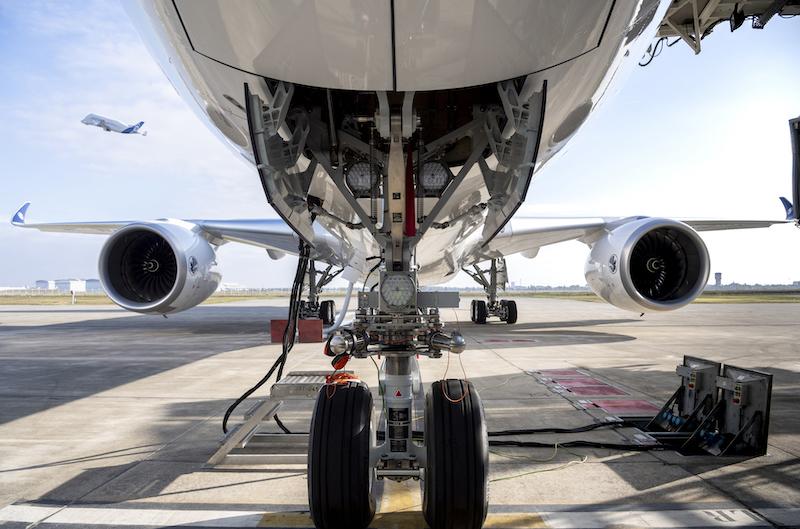
Airbus Sees Longer Aerospace Steel Lead Times, Continuing Supply Chain Challenges
See us at MRO Asia Pacific 2025
Airbus Sees Longer Aerospace Steel Lead Times, Continuing Supply Chain Challenges
Details
More Products & Services
Products & Services
Aerospace | Aviation Week Network
Aviation Week Network
https://aviationweek.com/themes/custom/particle/dist/app-drupal/assets/awn-logo.svg
Home - Aviation Group Marketing
Aviation Week Network
120 data points on over 156,000 commercial and business aviation aircraft, including military transports. Discover the most trustworthy resource for the complete aircraft history, plus ad hoc reports, month-over-month trend analysis and details on expected deliveries through 2050.
People

Andrea Rossi Prudente
Aviation Week Network

Anthony Lim
Aviation Week Network
Sales director

Becca Balmes
Aviation Week Network

Belinda Tan
Aviation Week Network

Brian Everstine
Aviation Week Network
Editor

Eddie Krankowski
Aviation Week Network
Assistant Manager, Tradeshows

erving dockery
Aviation Week Network

Lisa Tan
Aviation Week Network
Senior Marketing Manager

Mark Thomas
Aviation Week Network
Description
LE BOURGET—Airbus is seeing new materials shortages emerge in the aerospace supply chain as other issues that have dominated in recent months begin to settle down.
“There are new difficulties with raw materials, particularly aerospace steel,” Chief Operating Officer Alberto Gutierrez tells ShowNews at Paris Air Show.
Steel is used in some aircraft parts that are exposed to particularly strong forces, such as the landing gear, and it is also used in castings and forgings. The lead time for steel orders “used to be eight months—now it is 20 months,” Gutierrez says.
The steel shortage islinked to the much higher demand in the defense industry since the start of the war in Ukraine in early 2022. There are three suppliers of aerospace steel, with Liberty Steel continuing a complex and lengthy financial restructuring process. So far, deliveries have not been impacted.
But Airbus is trying to mitigate the issue by planning combined bids on behalf of its suppliers in the future. The bids would bundle the needs of all of the suppliers, and Airbus would place the order. While lower price for the higher volumes could be a positive side effect, Gutierrez says bringing down cost is not the primary objective. No firm decision on the consolidated bidding process has been made.
The aircraft manufacturer presented the proposal to its key suppliers on June 20 at an ad-hoc meeting here at Le Bourget. The approach is already being used for aluminum.
“Everyone is trying to build buffers,” Gutierrez says. “But in difficult times, that means someone else may get nothing.” A production delay or pause at one supplier can have devastating effects on the OEM and the rest of the supply chain, as it can hold up aircraft deliveries. Gutierrez believes that suppliers are “willing to participate” in the new steel acquisition process, as it enhances schedule safety for everyone.
At the meeting, Airbus shared its production plans with Tier 1 suppliers.
Overall, Gutierrez says that “[fewer] suppliers are in crisis” today than in 2022. The chip shortage that Airbus had to deal with last year has largely been overcome, although the knock-on effects are still being felt at some companies. Delays remain in seat deliveries, which are holding up aircraft.
“We are starting to do better, but it is not enough,” Gutierrez says. “2023 is going to be difficult, and 2024 will remain difficult, but there is now a higher level of resilience, and we can absorb difficulties [better].”
In spite of the new aerospace steel shortage and some of the other continuing issues, Gutierrez is confident that Airbus will meet its 2023 delivery target of 720 aircraft. Airbus handed over 661 aircraft in 2022, significantly fewer than it had planned at the beginning of last year.
Production through the end of May went “pretty much as planned,” Gutierrez says. Engine deliveries are secured through the end of the year, and Airbus is still negotiating with Pratt & Whitney, CFM International and Rolls-Royce on engine output for 2024 and 2025. The Airbus COO stresses that the company is taking into account the needs of its customers who are waiting for spare engines for aircraft that have already been delivered. “We want the fleet to fly,” he says.
Airbus shifted focused from just-in-time deliveries when the parts shortages began to emerge in order to build up stock. That approach continues for the time being, and Gutierrez believes Airbus can slowly return to just-in-time from around the middle of 2024. “It has to be the right point in time,” he says.
Looking ahead, Airbus is planning a major overhaul of its supplier relationships and how schedules and shipments are managed. “We have a transactional IT system, and we need to get to a collaborative system,” Gutierrez says, which would allow access to the entire supply chain. Such a system would enhance transparency of purchasing needs throughout the supply chain, he adds.
Artificial intelligence (AI) is to be used to identify bottlenecks early. Airbus has around 3,000 direct and 10,000 indirect suppliers. Around two million parts are delivered every day.
AI is already being used for 11 markers in the procurement wing of the Airbus Operating System. The markers—one of which signals how fast stock is depleted—are used to provide earlier warning signals to prevent shortages, Chief Procurement Officer Juergen Westermeier says.
With the new tool, Airbus can identify signs of potential issues five weeks in advance, thereby gaining time to take mitigating action. So far, the system includes Airbus and its affiliates Airbus Aerostructures and Airbus Atlantic, therefore giving it transparency over internal and Tier 1 components. At a future stage, the system could be expanded to include suppliers further down the chain. Rolling the system out on a broader basis will take until 2026, Gutierrez says.
“There are new difficulties with raw materials, particularly aerospace steel,” Chief Operating Officer Alberto Gutierrez tells ShowNews at Paris Air Show.
Steel is used in some aircraft parts that are exposed to particularly strong forces, such as the landing gear, and it is also used in castings and forgings. The lead time for steel orders “used to be eight months—now it is 20 months,” Gutierrez says.
The steel shortage islinked to the much higher demand in the defense industry since the start of the war in Ukraine in early 2022. There are three suppliers of aerospace steel, with Liberty Steel continuing a complex and lengthy financial restructuring process. So far, deliveries have not been impacted.
But Airbus is trying to mitigate the issue by planning combined bids on behalf of its suppliers in the future. The bids would bundle the needs of all of the suppliers, and Airbus would place the order. While lower price for the higher volumes could be a positive side effect, Gutierrez says bringing down cost is not the primary objective. No firm decision on the consolidated bidding process has been made.
The aircraft manufacturer presented the proposal to its key suppliers on June 20 at an ad-hoc meeting here at Le Bourget. The approach is already being used for aluminum.
“Everyone is trying to build buffers,” Gutierrez says. “But in difficult times, that means someone else may get nothing.” A production delay or pause at one supplier can have devastating effects on the OEM and the rest of the supply chain, as it can hold up aircraft deliveries. Gutierrez believes that suppliers are “willing to participate” in the new steel acquisition process, as it enhances schedule safety for everyone.
At the meeting, Airbus shared its production plans with Tier 1 suppliers.
Overall, Gutierrez says that “[fewer] suppliers are in crisis” today than in 2022. The chip shortage that Airbus had to deal with last year has largely been overcome, although the knock-on effects are still being felt at some companies. Delays remain in seat deliveries, which are holding up aircraft.
“We are starting to do better, but it is not enough,” Gutierrez says. “2023 is going to be difficult, and 2024 will remain difficult, but there is now a higher level of resilience, and we can absorb difficulties [better].”
In spite of the new aerospace steel shortage and some of the other continuing issues, Gutierrez is confident that Airbus will meet its 2023 delivery target of 720 aircraft. Airbus handed over 661 aircraft in 2022, significantly fewer than it had planned at the beginning of last year.
Production through the end of May went “pretty much as planned,” Gutierrez says. Engine deliveries are secured through the end of the year, and Airbus is still negotiating with Pratt & Whitney, CFM International and Rolls-Royce on engine output for 2024 and 2025. The Airbus COO stresses that the company is taking into account the needs of its customers who are waiting for spare engines for aircraft that have already been delivered. “We want the fleet to fly,” he says.
Airbus shifted focused from just-in-time deliveries when the parts shortages began to emerge in order to build up stock. That approach continues for the time being, and Gutierrez believes Airbus can slowly return to just-in-time from around the middle of 2024. “It has to be the right point in time,” he says.
Looking ahead, Airbus is planning a major overhaul of its supplier relationships and how schedules and shipments are managed. “We have a transactional IT system, and we need to get to a collaborative system,” Gutierrez says, which would allow access to the entire supply chain. Such a system would enhance transparency of purchasing needs throughout the supply chain, he adds.
Artificial intelligence (AI) is to be used to identify bottlenecks early. Airbus has around 3,000 direct and 10,000 indirect suppliers. Around two million parts are delivered every day.
AI is already being used for 11 markers in the procurement wing of the Airbus Operating System. The markers—one of which signals how fast stock is depleted—are used to provide earlier warning signals to prevent shortages, Chief Procurement Officer Juergen Westermeier says.
With the new tool, Airbus can identify signs of potential issues five weeks in advance, thereby gaining time to take mitigating action. So far, the system includes Airbus and its affiliates Airbus Aerostructures and Airbus Atlantic, therefore giving it transparency over internal and Tier 1 components. At a future stage, the system could be expanded to include suppliers further down the chain. Rolling the system out on a broader basis will take until 2026, Gutierrez says.

Share
Recent Chats
Share via email
Future: handle WhatsApp here
Future: handle LinkedIn here
Future: handle Twitter here
SUBMENU HERE
Share via Chat
Copy Link
